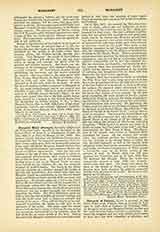

Marcianopolis, a titular see in Lower Moesia, on the right bank of the Danube, so called by Trajan after his sister Marciana (Amm. Marcellinus, 1kvII, 2) and previously known as Parthenopolis. Emperor Claudius II repeatedly repulsed the Goths rear this town (Trebellius Pollio, “Claudius”, 9; Zosimus, I, 42); Valens made it his winter quarters in 368 and succeeding years (Amm. Marcell., XXVII, 5; Theophanis, “Chronographia”, A.M. 5859, 5860, 5861). In 587 it was sacked by the king of the Avars, and at once retaken by the Romans (Theophanis, “Chronographia”, A.M. 6079). The Roman army quartered there in 596 before crossing the Danube to assault the Avars (op. cit., A.M. 6088). Marcianopolis was the home of many saints or martyrs, e.g., St. Meletina, whose feast is kept on September 15, and whose remains were carried to Lemnos; St. Alexander, martyred under Maximianus, and whose feast is kept on 2 Febr. Saints Maximus, Theodotus, Asclepiodotus, martyred at Adrianople under Maximianus, and whose feast is kept on September 15, were born at Marcianopolis. The “Ecthesis” of the pseudo-Epiphanius (c. 640) gives the Metropolitical See of Marcianopolis in the Balkans five suffragans (Gelzer, “Ungedruckte … Texte der Notitiae Episcopatuum“, 542). The “Notitia Episcopatuum” of the Armenian cleric, Basil (c. 840) confirms this (Gelzer, “Georgii Cyprii descriptio orbis romani”, 25). On the other hand Marcianopolis is not mentioned in the “Notitia” of Leo the Wise (c. 900), nor in that of Constantine Porphyrogenitus (c. 940), because the region had at that time been overrun by the Bulgarians. Le Quien (Oriens Christ., I, 1217-1220) mentions many bishops of Marcianopolis and Preslau, erroneously identifying these two towns. The Preslau of the Middle Ages remains Preslau to this day, and his Marcianopolis is now the village of Devna, a little to the west of Varna in Bulgaria. This name under the form Diabaina is mentioned by Pachymeros on account of something that took place there in 1280 (De Michaele Palaeologo, VI, 49).
S. VAILHE

